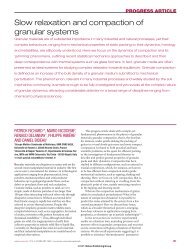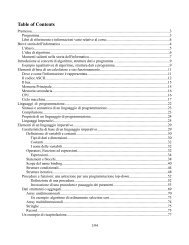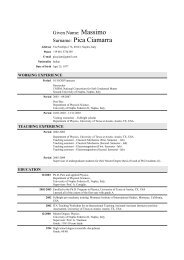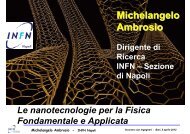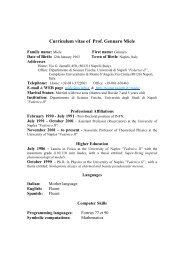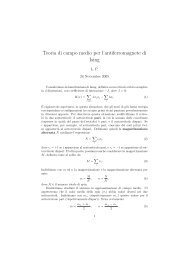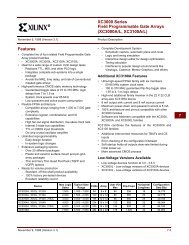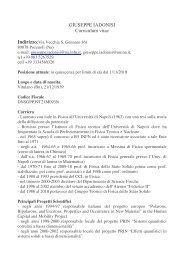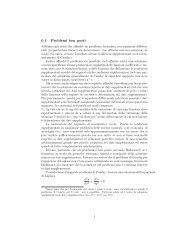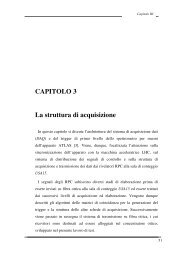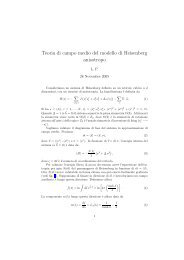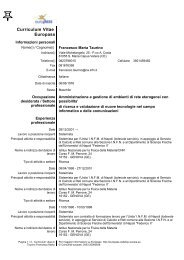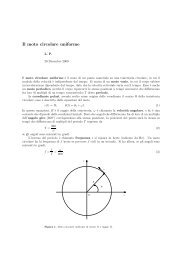Phys Rev E
Phys Rev E
Phys Rev E
Create successful ePaper yourself
Turn your PDF publications into a flip-book with our unique Google optimized e-Paper software.
LIGHT-INDUCED ROTATION OF DYE-DOPED LIQUID¼ PHYSICAL REVIEW E 73, 051707 2006<br />
like a rigid body. In this section we analyze theoretically a<br />
situation in which the director is not constrained to rotate<br />
together with the fluid flow. Such a situation may occur with<br />
appropriate boundary conditions for the director orientation<br />
and fluid motion at the droplet interface. We show that in this<br />
case the velocity field and the director rotation are influenced<br />
essentially by photoinduced effects.<br />
In order to keep the model manageable analytically, we<br />
assume here that the spatial distribution of the director in the<br />
droplet is always approximately uniform this assumption<br />
was unnecessary in the RBA model. Moreover, we will still<br />
consider the fluid motion to coincide with that of a rigid<br />
body.<br />
The dynamics of v and n fields will therefore still be<br />
taken to be given by Eqs. 21 and 22, but the two ’s<br />
entering these equations will be different, in general. Let us<br />
then label v and n the angular velocities of the fluid and<br />
director rotations, respectively.<br />
We can find two dynamical equations for n and v<br />
starting from Eqs. 1 and 2, respectively, and following a<br />
procedure similar to that used when finding Eq. 12. First,<br />
we integrate both sides of Eq. 1 over the whole droplet<br />
volume V d. Second, we multiply both sides of Eq. 2 vectorially<br />
by r and integrate over the whole volume V d. Owing to<br />
Eq. 16, we can then write the two resulting equations in the<br />
following form:<br />
dn InVd dt = Ttot ,<br />
I d v<br />
dt = Mtot − T tot ,<br />
28<br />
where the total external torque M tot = M is still defined by<br />
Eq. 15 and it is therefore identical to that used in the RBA<br />
model, and we have also introduced the total internal torque<br />
T tot = T exchanged between director and velocity degrees<br />
of freedom. More precisely, for each kind of interaction<br />
=hp,el,vis,em,ph, the torque T is simply defined as the<br />
volume integral of the torque density over the whole<br />
droplet.<br />
Equations 28 highlight the coupling between the droplet<br />
fluid rotation and the director dynamics inside the droplet.<br />
One recovers the RBA model when the internal torque T tot is<br />
very rigid and acts as a constraint that locks the director to<br />
the fluid.<br />
Since I n0 with excellent accuracy, from the first of Eqs.<br />
28 one finds T tot 0. Then the second of Eqs. 28 becomes<br />
identical to that of the RBA. This result, however, should not<br />
be taken as saying that within the UDA the droplet always<br />
behaves exactly as in the RBA, as the external torques M ,<br />
and in particular the electromagnetic one, can be affected by<br />
the director orientation in the droplet, which will not be the<br />
same as in the RBA. In particular, as we will see, the photoinduced<br />
effects will be present even in the first-order theory,<br />
in which they only appear via the internal torque T ph .<br />
Let us now calculate the internal torques T using the<br />
explicit constitutive dependence of the corresponding director<br />
torque densities . The hydrostatic pressure contribution<br />
051707-7<br />
vanishes identically. For a perfectly uniform director the<br />
elastic torque density el and therefore the total torque T el<br />
also vanish identically. However, it is not obvious that one<br />
can truly neglect the elastic torque density, as it is just this<br />
torque that keeps the director approximately uniform. If all<br />
other torque densities are always uniform then the director<br />
will remain uniform “spontaneously,” and the elastic torque<br />
density will indeed vanish. Whenever the other torque densities<br />
are nonuniform in our case, for example, the electromagnetic<br />
torque density is not very uniform in large droplets,<br />
their effect will give rise to a nonvanishing elastic<br />
torque density which balances them, in order to constrain the<br />
director to remain approximately uniform. At any rate, we<br />
assume here that the total elastic torque, obtained by integrating<br />
this elastic torque density over the whole droplet,<br />
remains always negligible. Further work will be needed to<br />
assess the validity of this assumption.<br />
Let us now consider the other interactions. The viscous<br />
torque under our assumptions is easily calculated and is<br />
given by<br />
T vis =− 1V d n − v, 29<br />
where 1 is the orientational viscosity coefficient 14,15.<br />
As for the electromagnetic term, under our hypothesis of<br />
uniform director UDA and spherical droplet SDA of constant<br />
density, it can be shown that the following identity<br />
holds with high accuracy:<br />
T em = M em . 30<br />
The proof of this identity is reported in the Appendix.<br />
Thereby, the calculation of T em =M em can be based on the<br />
PSA approximation, and its explicit expression is given by<br />
Eq. 18.<br />
Finally, the photoinduced term in first-order theory, the<br />
only one we consider in this section is simply related to the<br />
electromagnetic one when the latter is caused by an optical<br />
wave having a wavelength within the dye absorption band.<br />
In this case, since ph =/ a em , the photoinduced internal<br />
torque will be exactly given by<br />
Tph = <br />
M<br />
a em . 31<br />
However, it must be kept in mind that this strict relationship<br />
between the photoinduced and the electromagnetic torques is<br />
only valid when the electromagnetic field is that of an optical<br />
wave absorbed by the dye. It is instead possible to separately<br />
tune the electromagnetic and photoinduced torques by adding<br />
a second wave whose wavelength is out of the dye absorption<br />
band, or alternatively by adding static electromagnetic<br />
fields. In these cases, Eq. 31 will only apply to the<br />
contribution of the wave having a frequency within the dye<br />
absorption band.



